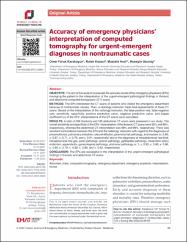Accuracy of emergency physicians' interpretation of computed tomography for urgent-emergent diagnoses in nontraumatic cases
| dc.contributor.author | Karakoyun, Ömer Faruk | |
| dc.contributor.author | Kozacı, Nalan | |
| dc.contributor.author | Avcı, Mustafa | |
| dc.contributor.author | Uzanay, Hüseyin | |
| dc.date.accessioned | 2022-05-18T13:07:17Z | |
| dc.date.available | 2022-05-18T13:07:17Z | |
| dc.date.issued | 2022 | en_US |
| dc.identifier.citation | Karakoyun, Omer Faruk et al. “Accuracy of emergency physicians' interpretation of computed tomography for urgent-emergent diagnoses in nontraumatic cases.” Turkish journal of emergency medicine vol. 22,2 89-95. 11 Apr. 2022, doi:10.4103/2452-2473.342804 | en_US |
| dc.identifier.issn | 2452-2473 | |
| dc.identifier.uri | https://hdl.handle.net/20.500.12809/9979 | |
| dc.description.abstract | Objective: The aim of this study is to evaluate the accuracy levels of the emergency physicians (EPs) managing the patient in the interpretation of the urgent-emergent pathological findings in thoracic and abdominal computed tomography (CT) scans. Methods: The EPs interpreted the CT scans of patients who visited the emergency department because of nontraumatic causes. Then, a radiology instructor made final assessments of these CT scans. Based on the interpretation of the radiology instructor, the false-positive rate, false-negative rate, sensitivity, specificity, positive predictive value, negative predictive value, and kappa coefficient (κ) of the EPs' interpretations of the CT scans were calculated. Results: A total of 268 thoracics and 185 abdominal CT scans were assessed in our study. The overall sensitivity and specificity of the EPs' interpretation of the thoracic CT scans were 90% and 89%, respectively, whereas the abdominal CT interpretation was 88% and 86%, respectively. There was excellent concordance between the EPs and the radiology instructor with regard to the diagnoses of pneumothorax, pulmonary embolism, pleural effusion, parenchymal pathology, and masses (κ: 0.90, κ: 0.87, κ: 0.71, κ: 0.79, and κ: 0.91, respectively) and to the diagnoses of intraabdominal free fluid, intraabdominal free gas, aortic pathology, splenic pathology, gallbladder pathology, mesenteric artery embolism, appendicitis, gynecological pathology, and renal pathology (κ: 1, κ: 0.92, κ: 0.96, κ: 0.88, κ: 0.80, κ: 0.79, κ: 0.89, κ: 0.88, and κ: 0.82, respectively). Conclusion: The EPs are successful in the interpretation of the urgent-emergent pathological findings in thoracic and abdominal CT scans. | en_US |
| dc.item-language.iso | eng | en_US |
| dc.publisher | EMAT | en_US |
| dc.relation.isversionof | 10.4103/2452-2473.342804 | en_US |
| dc.item-rights | info:eu-repo/semantics/openAccess | en_US |
| dc.subject | Abdomen | en_US |
| dc.subject | Chest | en_US |
| dc.subject | Computed tomography | en_US |
| dc.subject | Emergency department | en_US |
| dc.subject | Emergency physician | en_US |
| dc.subject | Interpretation | en_US |
| dc.subject | Thorax | en_US |
| dc.title | Accuracy of emergency physicians' interpretation of computed tomography for urgent-emergent diagnoses in nontraumatic cases | en_US |
| dc.item-type | article | en_US |
| dc.contributor.department | MÜ, Tıp Fakültesi, Eğitim ve Araştırma Hastanesiü | en_US |
| dc.contributor.authorID | 0000-0002-4476-7989 | en_US |
| dc.contributor.institutionauthor | Karakoyun, Ömer Faruk | |
| dc.identifier.volume | 22 | en_US |
| dc.identifier.issue | 2 | en_US |
| dc.identifier.startpage | 89 | en_US |
| dc.identifier.endpage | 95 | en_US |
| dc.relation.journal | Turkish Journal of Emergency Medicine | en_US |
| dc.relation.publicationcategory | Makale - Uluslararası Hakemli Dergi - Kurum Öğretim Elemanı | en_US |


















